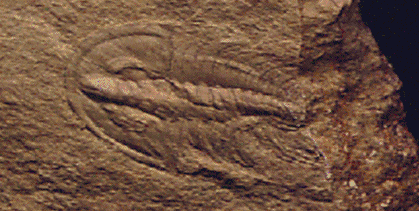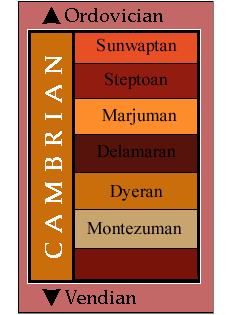The Cambrian Period
543 to 490 Million Years Ago


The Cambrian Period marks an important point in the history of life on earth; it is the time when most of the major groups of animals first appear in the fossil record. This event is sometimes called the "Cambrian Explosion", because of the relatively short time over which this diversity of forms appears. It was once thought that the Cambrian rocks contained the first and oldest fossil animals, but these are now to be found in the earlier Vendian strata.
Click on the buttons below to learn more about the Cambrian.

|
Cambrian: The chart at left shows the major subdivisions of the Cambrian Period for North America (Laurentia during the Cambrian). International ages (subdivisions) have not been established. The size of the bars does not correlate with the length of time for each age. The oldest unnamed age is 543 to 520 million years ago, while the remaining six ages are from 520 to 490 million years ago, each approximately 5-6 million years long. This chart is mapped to allow you to travel back to the Vendian, or forward to the Ordovician. You may also click to see our close-up look at the Tommotian. The Cambrian Period is part of the Paleozoic Era. |
The International Subcommittee on Cambrian Stratigraphy maintains a page with lots of technical information on the Cambrian. You can also take a look at the University of Calgary's exhibit on the Burgess Shale, in present-day British Columbia, a Middle Cambrian site known for its excellent preservation of soft-bodied invertebrates.
A Science article discusses continental movement and polar wander in the Cambrian.
Find out more about the Cambrian paleontology and geology of North America at the Paleontology Portal.


